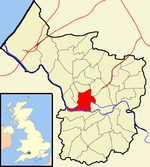Tyndale Baptist Church

Tyndale Baptist Church is a Baptist church in Whiteladies Road, Redland, in Bristol, England. The church was founded in 1869, following an initiative by Broadmead Baptist Church to establish a church to serve the growing population of Redland. Funds to build the new church were raised by a committee chaired by E. S. Robinson, founder of the paper and packaging business E. S. & A. Robinson, and mayor of Bristol in 1866. The first minister was the Revd Richard Glover (1837–1919), President of the Baptist Union in 1884 and active in promoting the work of the Baptist Missionary Society. Glover served the church until 1911.Several members of the church were prominent in Bristol public life. The first Lord Mayor of Bristol in 1899, Sir Herbert Ashman, was baptized by Glover. Edward Robinson, a son of E. S. Robinson, was Lord Mayor in 1908. Charles Townsend, M.P. for Bristol North from 1892 to 1895, was church secretary for more than 20 years.
Excerpt from the Wikipedia article Tyndale Baptist Church (License: CC BY-SA 3.0, Authors, Images).Tyndale Baptist Church
Whiteladies Road, Bristol Westbury Park
Geographical coordinates (GPS) Address Phone number Website External links Nearby Places Show on map
Geographical coordinates (GPS)
| Latitude | Longitude |
|---|---|
| N 51.46547 ° | E -2.61009 ° |
Address
Tyndale Baptist Church
Whiteladies Road
BS8 2QG Bristol, Westbury Park
England, United Kingdom
Open on Google Maps







